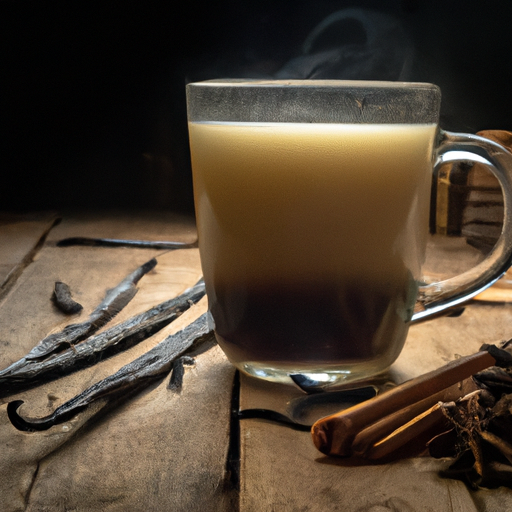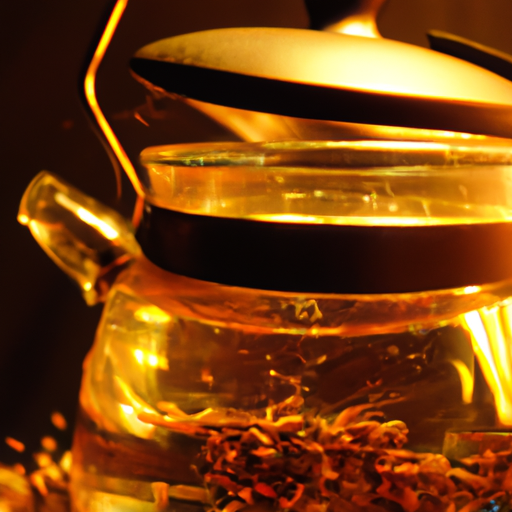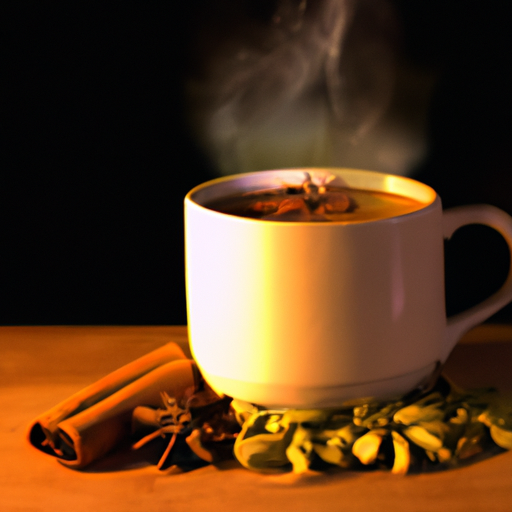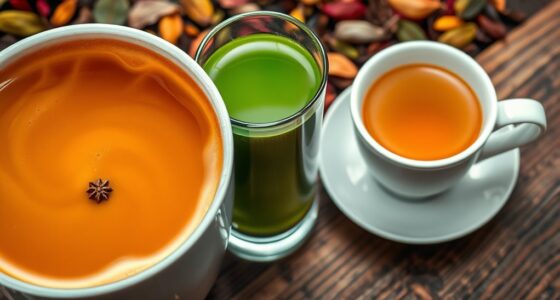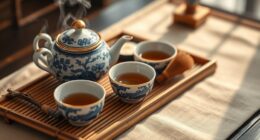On a cool fall night, I found myself desiring something that would warm and soothe me. While searching through my pantry, I came across some loose leaf tea and a jar of vanilla extract.
Suddenly, an idea struck me – why not make some homemade vanilla chai tea? With a quick Google search for the recipe, I was ready to dive into the world of homemade chai.
And let me tell you, it did not disappoint! The aromatic blend of spices and creamy vanilla made for the perfect cozy drink to sip on while curled up with a good book.
If you’re also looking for a delicious DIY beverage to enjoy on those chilly fall days, look no further than this simple recipe for making your own vanilla chai tea.
Key Takeaways
- Homemade vanilla chai tea requires black tea leaves, whole spices (cinnamon sticks, cardamom pods, cloves, ginger root), and vanilla extract or vanilla beans.
- Customizing the spice blend and milk choice is crucial for a unique and satisfying flavor profile.
- Strain loose tea leaves or spices before enjoying tea and add toppings such as cinnamon, nutmeg, brown sugar, or honey.
- Vanilla chai tea can be enjoyed hot or iced, and spice levels should be adjusted to find the perfect balance for personal taste.
Gather Your Ingredients
Now it’s time to gather all the ingredients you need for your delicious vanilla chai tea! To make a perfect cup of vanilla chai tea, you’ll need black tea leaves, whole spices such as cinnamon sticks, cardamom pods, cloves, and ginger root. You can also use ground spices if you don’t have whole ones on hand. Don’t forget vanilla extract or vanilla beans to give that rich and sweet flavor to your tea.
If you want to experiment with your recipe or have dietary restrictions, there are many ingredient substitutions available. For example, almond milk instead of regular milk can create a nuttier taste without adding any dairy products. You can also add honey or agave syrup instead of sugar for a healthier option. Using green tea instead of black tea leaves is another alternative for those who want something lighter.
In addition to being a tasty beverage, chai tea has many health benefits too! The combination of spices in this drink has been shown to improve digestion and reduce inflammation in the body. It’s also known for its calming properties and can help reduce stress levels.
With all these benefits, it’s no wonder why so many people love drinking vanilla chai tea!
Now that we’ve gathered our ingredients, let’s move on to preparing the tea leaves and spices.
Prepare Your Tea Leaves
First, you’ll need to choose your preferred blend of fragrant leaves and spices before steeping them in hot water. When it comes to tea brewing techniques, there are a few things to keep in mind. Choose high-quality tea leaves that are fresh and have been stored properly. Look for blends that contain black tea as the base, which pairs beautifully with the warm spices typically found in chai.
Next, prepare your tea leaves by measuring out the desired amount according to your taste preference and the size of your cup or teapot. You can use loose leaf tea or pre-packaged tea bags, depending on what you have available. If using loose leaf tea, place it in a strainer or infuser ball for easy removal later on. For optimal flavor extraction, use filtered or spring water that has been brought to a rolling boil.
When choosing tea blends for vanilla chai, consider options such as Assam black tea mixed with cinnamon sticks, cardamom pods, cloves, ginger root, and fennel seeds. Another option is Darjeeling black tea blended with vanilla bean and nutmeg for a more floral flavor profile.
Once you’ve prepared your chosen blend of leaves and spices according to your preferences, it’s time to move on to adding the finishing touches – adding your spices!
Now that we’ve covered how to prepare your chosen blend of fragrant leaves and spices for steeping, let’s move on to adding those deliciously aromatic spices like cinnamon and ginger into the mix!
Add Your Spices
Now that I’ve got my tea leaves ready, it’s time to add the spices. Traditional chai spices include cinnamon, cardamom, ginger, and cloves. However, I like to customize my spice blend based on my personal taste preferences.
By experimenting with different combinations of spices, you can create a unique flavor profile that perfectly suits your palate.
Traditional Chai Spices
To add traditional chai spices to your tea, you’ll want to start by crushing some whole cardamom pods with the flat side of a knife. Cardamom is one of the most important ingredients in chai and has been used for centuries in Indian Ayurvedic medicine to aid digestion, freshen breath, and alleviate respiratory issues. Along with cardamom, cinnamon and ginger are also commonly used in traditional chai blends.
The following table lists the traditional chai spices along with their health benefits:
| Spice | Health Benefits |
|---|---|
| Cardamom | Aids digestion, freshens breath, alleviates respiratory issues |
| Cinnamon | Lowers blood sugar levels, reduces inflammation |
| Ginger | Relieves nausea and muscle pain |
Now that you have added the traditional spices to your tea, it’s time to move on to customizing your spice blend based on your personal preferences.
Customizing Your Spice Blend
When customizing your spice blend, it’s important to experiment with different combinations of spices in order to achieve a unique and personalized flavor profile. Spice pairing is an art form that involves understanding the flavors of each individual spice and how they work together in harmony.
For example, cinnamon and cardamom are often paired together for their complementary sweet and spicy notes, while cloves add a warm depth to the mix. Flavor experimentation is key when creating your own chai spice blend.
Try adding spices like nutmeg or allspice for a hint of warmth, or ginger for a zesty kick. Don’t be afraid to adjust the ratios of each spice until you find the perfect combination that suits your taste buds. Once you’ve created your ideal blend, it’s time to simmer the spices with black tea and milk for a delicious cup of homemade vanilla chai tea.
Simmer the Spices
First things first, you’ll need to get those aromatic spices simmering in a pot of water. Spice variations are endless and it can be overwhelming to choose the right blend for your vanilla chai tea. To make it easier, start with cinnamon, cardamom, cloves, and ginger. These spices have a perfect balance that’ll give you that delicious aroma and flavor you’re looking for.
Infusion techniques vary as well – some people prefer boiling the spices directly in the water, while others use a tea infuser or cheesecloth.
Once you’ve chosen your preferred spice blend and infusion technique, add the spices to a pot of water and bring it to a boil. Reduce heat to low and let it simmer for at least 10 minutes. This’ll allow all the flavors from the spices to be released into the water, resulting in a rich, flavorful base for your vanilla chai tea.
After simmering the spices for about 10 minutes or more, turn off the heat and strain out any whole pieces of spice using a fine mesh strainer or cheesecloth. At this point, you can either discard them or save them for another batch of tea later on!
Now that your spiced base is ready, it’s time to move on to adding milk and sweetener, which’ll complete your perfect cup of vanilla chai tea without compromising its authentic taste.
Add Milk and Sweetener
Now that the spices have been simmered, it’s time to add the milk and sweetener.
Choosing the right type of milk is crucial for achieving that perfect creamy texture and taste.
You can also add your preferred sweetener to balance out the spice flavors.
Choosing the Right Milk
To get the best taste and texture, you’ll want to choose a creamy milk like whole milk or coconut milk for your vanilla chai tea. Don’t cry over spilled milk, though – almond or soy milk can also work well depending on your preference. When it comes to choosing the right type of milk, there are several factors to consider.
Firstly, if you prefer a richer and creamier taste, whole milk or full-fat coconut milk are great options. These milks have higher fat content which gives them a smooth and velvety texture that complements the spicy flavors of chai tea. On the other hand, if you’re looking for a lighter option, almond or soy milk can be used instead. These non-dairy milks have fewer calories and less fat but still offer a similar flavor profile to dairy-based milks.
In addition to the type of milk you choose, it’s important to pay attention to how much you add. Too much milk can dilute the flavors while too little can make the tea too strong and spicy. A good rule of thumb is to use about 1/3 cup of milk per serving of tea. With that in mind, let’s move on to adding sweetener for an extra touch of indulgence in your vanilla chai tea.
Adding Sweetener
For a touch of sweetness that’ll transport you to a cozy café, consider adding a dollop of honey or maple syrup to your steaming cup of spiced milk. These sweetener options not only enhance the flavor profile but also offer numerous health benefits.
Here are four reasons why adding honey or maple syrup to your vanilla chai tea is a great idea:
- Honey has antibacterial and anti-inflammatory properties that can help soothe sore throats and coughs.
- Maple syrup contains antioxidants that can reduce inflammation and improve heart health.
- Both honey and maple syrup have lower glycemic indexes than regular sugar, making them better alternatives for those with diabetes or who want to maintain blood sugar levels.
- Unlike artificial sweeteners, honey and maple syrup are natural sources of energy that can boost metabolism.
As you finish up sweetening your vanilla chai tea, remember to strain the tea bags before enjoying your warm beverage.
Strain Your Tea
Don’t forget to strain your freshly brewed vanilla chai tea for a smooth and delicious taste. Tea brewing techniques vary, but it is important to ensure that any loose tea leaves or spices are removed before enjoying your cup of tea. There are several strainer options available, each with their own benefits.
One popular option is the mesh strainer, which can be placed over a cup or teapot to catch any loose particles while allowing the liquid to flow through easily. Another option is the traditional tea ball, which can be filled with loose leaf tea and then placed into hot water to steep. Finally, there are disposable paper filters that can be used for easy clean-up.
Once you have chosen your preferred straining method, simply pour your freshly brewed vanilla chai tea through the strainer and into your cup or mug. This will remove any excess spices or leaves and give you a smoother texture in every sip. Now that your tea has been strained, it’s time to add some vanilla for an extra burst of flavor.
Adding vanilla extract or syrup is an easy way to enhance the taste of your chai tea. Simply measure out 1-2 teaspoons of vanilla extract or syrup per cup of tea and stir until well combined. The sweetness of the vanilla will complement the spicy notes in the chai blend perfectly, creating a warm and comforting beverage that is perfect for any time of day. So go ahead and try adding some vanilla to your freshly strained chai tea – you won’t regret it!
Add Vanilla
Now it’s time to add some vanilla to our chai tea!
There are two main ways to incorporate vanilla into your tea: using vanilla extract or using a vanilla bean. Vanilla extract is made by soaking vanilla beans in alcohol, resulting in a concentrated liquid flavoring. The advantage of using extract is that it’s easier to measure and adds consistent flavor.
However, if you want to use whole ingredients, you can also add a split vanilla bean directly into the pot while steeping your tea for an extra burst of flavor.
Vanilla Extract
Vanilla extract adds a sweet and creamy flavor to the chai tea, making it an essential ingredient for a truly delicious cup. It is commonly used in baking due to its ability to enhance other flavors and add depth to desserts. In fact, vanilla is one of the most widely used flavors in baking, with its presence in cakes, cookies, and ice cream.
When adding vanilla extract to your chai tea recipe, make sure you use pure vanilla extract rather than imitation vanilla. The pure version is made from real vanilla beans and contains no artificial ingredients or additives. Just a few drops of this liquid gold will transform your chai tea into a warm and comforting treat that’s perfect for any occasion.
Moving on to the next section about ‘vanilla bean’, let’s explore another way to incorporate this flavorful ingredient into our homemade chai tea recipe.
Vanilla Bean
Using a fresh vanilla bean in your homemade beverage can add natural sweetness and complexity to your recipe, creating a unique and indulgent experience for your taste buds. The benefits of using real vanilla beans in tea are numerous – not only does it enhance the flavor profile of the drink, but it also adds an aromatic element that can be enjoyed before even taking a sip.
If you’re looking to incorporate vanilla beans into other recipes, they can be used in everything from baked goods to savory dishes. Simply split the bean lengthwise with a sharp knife and scrape out the seeds inside, which can then be added to your desired recipe.
And when it comes to making vanilla chai tea specifically, using a fresh vanilla bean is an excellent way to elevate the flavors and create a truly memorable beverage.
Now that we have our ingredients ready, let’s move on to stirring and serving our delicious homemade tea.
Stir and Serve
Now that our vanilla chai tea is brewed and ready to serve, let’s talk about how to make it look as good as it tastes.
One option for garnishing is adding a cinnamon stick or a sprinkle of ground cinnamon on top. Another option is to add a dollop of whipped cream or frothed milk for a creamier texture.
When serving, consider pairing with some baked goods like scones or muffins for a cozy and satisfying treat.
Garnishing Options
To add some visual appeal to your chai tea, spice alternatives like cinnamon and nutmeg can be used as toppings. These spices not only enhance the flavor but also make for a beautiful presentation. For those who prefer a sweeter taste, try adding a sprinkle of brown sugar or honey on top.
Another unique presentation idea is to serve your vanilla chai tea with a cinnamon stick or star anise as a stirrer. This adds an extra touch of flavor and aroma to the drink while also looking aesthetically pleasing.
With these garnishing options, your vanilla chai tea will surely impress guests and satisfy your taste buds.
When it comes to serving suggestions, there are various ways to enjoy your freshly made vanilla chai tea. Whether you prefer it hot or iced, this beverage can be paired with cookies or scones for the perfect snack time treat.
Alternatively, consider serving it alongside breakfast dishes such as pancakes or French toast for a cozy morning meal.
Serving Suggestions
Savor the rich and indulgent taste of your favorite warm beverage by pairing it with freshly baked cookies or scones, or enjoy it as a comforting accompaniment to a hearty breakfast spread featuring fluffy pancakes and crispy French toast. Here are some tea pairings and presentation ideas that can take your vanilla chai experience to the next level:
-
Fresh fruit platter: A refreshing fruit platter is an excellent option for those who prefer lighter snacks. Fruits like strawberries, blueberries, and raspberries complement the spiciness of vanilla chai perfectly.
-
Chocolate treats: Vanilla chai tea pairs well with chocolatey treats such as brownies, chocolate chip cookies or even dark chocolate truffles.
-
Cheese platter: Another great option is cheese! Pairing chai tea with different types of cheese like brie or gouda adds depth to the flavor profile.
-
Spicy Snacks: For those who love spice, consider serving samosas, pakoras or other spicy Indian snacks alongside your vanilla chai tea.
As you think about how best to serve your delicious vanilla chai tea, remember that everyone’s tastes are unique! Keep reading for our tips on customizing this recipe according to your preferences.
Tips for Customizing Your Vanilla Chai
When it comes to customizing my vanilla chai tea, I like to experiment with different flavors and spice levels. Adding a splash of almond milk or honey can give the drink a creamy sweetness, while a pinch of cardamom or ginger can add an extra kick of spice. By adjusting these elements to my personal taste preferences, I can create a unique and satisfying cup of chai every time.
Adjust the paragraph structure in the Input to logically group complete sentences on their own lines, with a double new line after. Use contractions.
Adding Flavors
Enhance the flavor of your vanilla chai tea by incorporating spices such as cinnamon, cardamom, and ginger. These spices are commonly used in traditional chai recipes and can add depth and complexity to your vanilla chai. You can experiment with different spice combinations to find the perfect balance of flavors for your taste buds.
To help you get started, here is a table with some common spice combinations that work well with vanilla chai:
| Spice Combination | Flavor Profile |
|---|---|
| Cinnamon + Cloves | Warm and Sweet |
| Ginger + Cardamom | Spicy and Floral |
| Nutmeg + Allspice | Earthy and Aromatic |
| Black Pepper + Star Anise | Bold and Complex |
Adjusting spice levels is crucial when adding flavors to your vanilla chai tea. Too much of one spice can overpower the other flavors, while too little may not be noticeable. In the next section, we will explore how to adjust the amount of spices in your recipe to achieve a perfectly balanced cup of vanilla chai tea.
Adjusting Spice Levels
To get the perfect balance of flavors in your cup, you’ll want to tweak the amount of spices you use when making vanilla chai tea. Adjusting spice levels can help you achieve a milder or spicier taste, depending on your preference.
If you’re looking for a milder flavor, start by reducing the amount of ginger and black pepper in your recipe. You can also try using less cinnamon and cardamom, which are strong flavors that can easily overpower other ingredients.
On the other hand, if you want a spicier vanilla chai tea, increase the amounts of ginger and black pepper in your recipe. Add an extra pinch of cloves as well, since this spice has a warm and rich flavor that will complement the other spices nicely.
Keep in mind that adjusting spice levels is all about finding the perfect balance for your taste buds. Don’t be afraid to experiment with different quantities until you find what works best for you.
With these tips for adjusting the spices in your vanilla chai tea recipe, you’ll be able to create a deliciously flavorful cup every time!
Frequently Asked Questions
What is the origin of chai tea?
As a tea enthusiast, I’m fascinated by the history and culture surrounding chai tea.
The origins of this spiced beverage can be traced back to ancient India. It was traditionally consumed for its warming and medicinal properties. Over time, chai evolved into a popular social drink enjoyed by people from all walks of life.
Today, chai is enjoyed around the world as a symbol of hospitality and community. Its rich blend of spices, including cinnamon, cardamom, ginger, cloves, and black pepper, make it an aromatic and flavorful treat that can be customized to suit individual tastes.
Understanding the history and cultural significance of chai adds depth to our appreciation for this beloved beverage.
Can I use a different type of milk instead of dairy milk in the recipe?
Yes, you can definitely use a different type of milk instead of dairy milk in your vanilla chai tea recipe. Almond milk is a great substitution for dairy milk as it has a subtle nutty flavor that complements the spices in chai tea. It is also low in calories and high in nutrients such as vitamin E and calcium.
Soy milk is another alternative that works well in chai tea recipes, as it has a creamy texture and mild taste that won’t overpower the flavors of the tea. When using alternative milks, be sure to heat them up slowly to avoid curdling or separating.
Overall, both almond and soy milk are great options for those who are lactose intolerant or looking for a plant-based alternative to dairy.
How long can I store leftover chai tea in the fridge?
Oh, how amusing it is to think that someone might actually have leftover chai tea! But in all seriousness, if you do happen to have some remaining, it’s important to know how to properly store it.
The shelf life of chai tea can vary depending on a few factors such as the ingredients used and whether or not any milk was added. Generally speaking, though, I would recommend consuming your leftover chai within 2-3 days of making it.
To preserve the flavors and prevent spoilage, keep your chai tea in an airtight container in the refrigerator. Be aware that flavor changes may occur over time and reheating the tea could intensify these changes.
If you’re unable to consume your chai within a few days, consider freezing it for longer storage. Just be sure to transfer the tea into freezer-safe containers and leave enough room at the top for expansion during freezing.
When ready to drink again, thaw in the refrigerator overnight and give it a good shake before reheating on the stove or in the microwave until hot.
Can I use ground spices instead of whole spices in the recipe?
When experimenting with flavor intensity in chai tea, using ground spices can be a convenient alternative to whole spices. However, it’s important to keep in mind that ground spices tend to lose their flavor more quickly than whole spices. This means that it may be necessary to use a bit more of them or replace them more frequently.
Additionally, when using ground spices, the texture and appearance of the finished product may differ slightly from what you would achieve with whole spices. Despite these trade-offs, there are alternatives to whole spices when making chai tea. It’s worth considering the options and experimenting with both to find what works best for your taste preferences and desired outcome.
How can I make the tea stronger or weaker based on my preference?
When it comes to adjusting the flavor of tea, there are a few different brewing techniques you can use depending on your preferences.
One simple way to make tea stronger is to use more tea leaves or bags per cup of water. For example, if you typically brew one teaspoon of loose leaf tea, try using two teaspoons instead.
Another option is to steep the tea for a longer period of time. This will release more tannins and other compounds from the leaves, resulting in a stronger and more robust flavor.
On the other hand, if you prefer weaker tea, you can simply use less tea or shorten your steeping time. Keep in mind that these adjustments may also affect the overall taste and balance of flavors in your chai blend, so be sure to experiment until you find the perfect strength for your palate.
Conclusion
Well, folks, that’s how I make my delicious vanilla chai tea! It may seem like a lot of steps, but trust me, it’s worth it in the end.
The combination of black tea and warm spices with a touch of sweetness and creaminess from the milk and vanilla is simply divine.
Nowadays, there are many variations of chai tea out there, but for me, nothing beats a classic vanilla chai. It’s the perfect drink to cozy up with on a chilly day or to enjoy as an afternoon pick-me-up. So why not give it a try? You might just discover your new favorite beverage!
And remember, don’t be afraid to experiment with different spices or sweeteners to make this recipe your own. Whether you prefer it spicier or sweeter, there’s no wrong way to enjoy a cup of homemade vanilla chai tea. So go ahead and whip up a batch today – you won’t regret it! As they say, "a sip of this heavenly concoction will transport you straight back in time".

